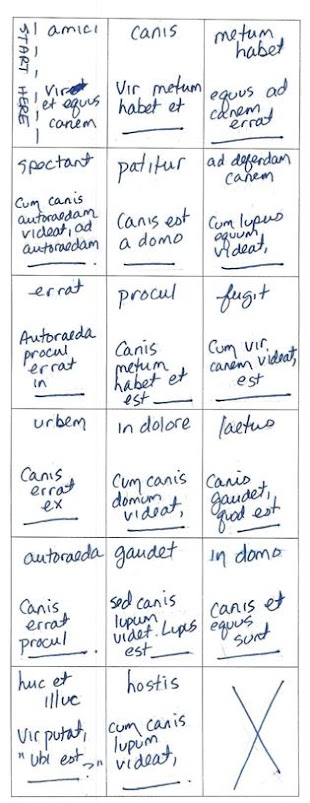- On a MS Word or Google Docs document, create a table in which the cells are long in height and resemble domino tiles. I usually do a table of 3x6 (18 cells) or 4x6 (24 cells).
- Print up the document.
- On the top left hand cell, on the side, handwrite "Start Here"
- Now in that cell handwrite the first sentence of your reading but leave the last word blank. This may require you editing your sentence to fit the cell. NOTE - you do not always have to leave the last word blank, but I have found that visually it is easier for students to see than if a word in the middle is left blank.
- On the cell below it, at the TOP of that cell, write that missing word.
- Then below that word, write the next sentence from the story but leave the last word blank. Again, this may require you editing the sentence to fit the cell.
- On the cell below it, at the TOP of that cell, write that missing word.
- Continue this pattern.
- When you get to the last cell/sentence of the reading, the missing word will be written on the top of the "Start Here" cell.
- Make 10 copies of this table for a class of 30 - I usually use colored card stock, because card stock is firm and not flimsy like regular paper.
- Cut the cells into "domino tiles," and put each set in a separate plastic Ziploc bag (the snack-sized bags are good).
Activity
- Group students into 3's (a class of 30 would have 10 groups).
- Have students take the cards out of the bag and lay them out on a flat surface.
- Have them find the card which says "Start Here."
- Tell them that their job is to recreate the reading by finding the missing word of that sentence. That word is found at the top of another card.
- Like dominoes, students will line up that card underneath the "Start Here" card.
- Now students have a new sentence with a missing word, and their job is find that missing word.
- Tell students that the final card's missing word will be the one at the top of the "Start Here" card.
- As students begin to have less cards remaining, the activity should become easier.
- Optional competition - I have a bell at the front of my class that students ring when they think that they are done. I then will check that group's cards to make sure that the cards are correct.
- When the activity is done, have students scramble the cards before they return them so that they are out of order for the next class.
Observations
- I suppose one could create this digitally instead of handwriting the sentences. It would require you creating a fillable, set template where the parameters of the table do not change when typing in the sentences. If you can figure out how to do this, go for it.
- This activity usually lasts around 5-10 minutes.
- 18-24 "cards" are a good amount - anything less than that is too quick and anything more can get long for students.
- You cannot have duplicate words on the tops of cards, because that would mess up groups' domino orders. Every word on the top of the cards must be distinct.
- Students can self-monitor their progress when they do this activity because if they "finish" but there are cards still remaining, then they have made a mistake somewhere.
- I have seen this activity adapted on Textivate. Since that is a pay-site, I have not used it.
- I have a deskless classroom, so this activity does not really lend itself well to playing on the floor since the cards are small. However, when I did have desks, I did this activity a lot!
- I found that students liked the tactile nature of the activity. Plus, it helped students see the story arranged visually.
- I like the collaborative nature of the activity, because students really do communicate with each other to find the next "domino" which completes the sentence.
- I do not understand why students like ringing the bell when they are finished but they do! Therefore, I have to ensure that even the last group to finish gets the chance to ring the bell.
- I would scaffold this activity for later in a reading's lesson plans, because students really need to know the reading well (and vocabulary) to be able to complete the sentence with the missing word.
- I do like how this requires students to re-read the story again in a completely different way (and to receive repetitions of understandable messages in their re-reading) but the focus isn't on comprehension anymore but on completing the sentence with the missing words.

trying this in a couple of days! Thanks!
ReplyDeleteHope it goes well! Since I don't have desks any more in my classroom, I have not done this activity in years (it doesn't work well on the floor), but I really did like doing this with students. And once students got the concept, it was an activity with which they were very familiar when we would do it later.
Delete